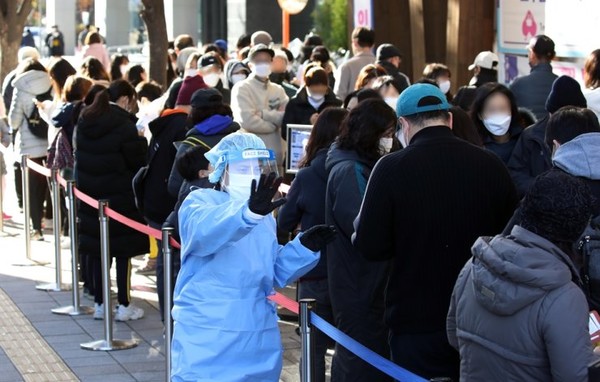Near the end of last month, the Korean government announced the beginning of the end for the strict — and often confusing — restrictions on businesses and public gatherings. From November 1, the first stage of a gradual reopening of normal society is being implemented, as part of a three-phase plan to lift the restrictions put in place to minimize the spread of COVID-19 until now. This move follows the achievement of the 70% population vaccination mark; more than 39 million Korean citizens have been fully vaccinated over the last eight months. The government plans also detailed the introduction of a “vaccine pass” system, requiring proof of vaccination for entry into high-risk multi-use facilities. While at some points during the pandemic, South Korea has had some of the most stringent COVID-19 response policies, this move has sped the reduction in strictness compared to other countries, according to data from the University of Oxford COVID-19 Response Tracker.

Korea’s three-phase “Living with COVID-19” plan — also known as “With Corona” in Korean — is expected to transition through the phases at intervals of four weeks, with a two-week evaluation period in each to determine its suitability. This means it may be possible to enter Phase 2 in mid-December, and Phase 3 in the new year. The transition between phases is also reliant on the evaluation of criteria including increasing vaccination rate, hospital bed availability, the scale of new infection trends, and the number of deaths. While it is expected that the rate of COVID-19 cases will rise, given the high vaccination rate, it is hoped that outbreaks will remain contained, as well as presenting with less severe symptoms. As such, the new plan also includes a switch in confirmed case treatment from quarantine facilities to primarily home quarantine and treatment for asymptomatic or mildly ill patients.
Throughout this transition to “Living with COVID-19”, contact tracing and the mandatory recording of visitors in public facilities will continue, such that close contacts at risk of infection can be identified. However, the ten-day mandatory self-quarantine period (previously reduced from 14 days) does not apply to close contacts who have completed vaccination, provided they complete three PCR tests within the same ten day period, according to Daejeon city policy.

In Phase 1, we are already experiencing the benefits of eased restrictions, including the increased limit on the number of people gathering in restaurants or bars. To be specific, for areas outside Seoul, the ceiling on private gatherings has been raised to allow a maximum of 12 people, including eight fully vaccinated for restaurants; in the capital city and surrounding region, the limit is ten. Phase 1 also includes the lifting of operation hours restrictions on all businesses except “night entertainment facilities” such as clubs. Large-scale events are now permitted to have up to 100 attendees regardless of vaccination status, and up to 500 if fully vaccinated, with some exceptions for irregular concerts, sports contests, and festivals.
In Phase 2, we will see further lifting of restrictions, including the allowance of indoor eating at entertainment facilities such as cinemas and the removal of curfews for clubs. Phase 3 will mark a near-total return to regular life, removing capacity limits on events and private gatherings. However, less than two weeks into the implementation of Phase 1, an official statement from Eun-kyeong Jeong, commissioner of the Korea Disease Control and Prevention Agency, admitted that it may be difficult to move to the next stage if cases continue to grow. Korea recorded 2,520 new COVID-19 cases on November 11, in an ongoing spike that began shortly after restrictions were eased. Many speculate, however, that this rise has also been in part related to gatherings for Halloween on October 31. Daily cases are still reasonably below the record peak of 3,272 on September 25, but “if the current trend continues, we will need to maintain the first phase or tighten virus restrictions,” Jeong said during a parliamentary session.
What Korea’s slow return to normal life within the country means for international travel and immigration is still unclear. Quarantine — reduced to ten days — in government facilities is still required for tourists, whereas ARC holders can quarantine at home, or avoid it if vaccinated in Korea. However, while quarantine exemptions for Koreans vaccinated abroad are being granted, foreigners in the same circumstance must currently still complete it, despite calls from several embassies to end the imbalance in policy. The newly released “Living with COVID-19” plan includes details about a quarantine classification system to be implemented from December 1, based on the risk level of different countries. This puts international arrivals into three categories: Level 1 countries (safe countries) receive quarantine exemption when fully vaccinated and there will be no restrictions on visa deliveries; Level 2 countries (general countries) will maintain the quarantine for now, but lift the requirement for fully-vaccinated people from the first semester 2022, though there may still be some restrictions on visa deliveries; and Level 3 countries (high-risk countries) will be subject to quarantine requirements indefinitely, as well as restrictions on visa deliveries and air routes. It is not clear how these classifications will be decided, but Korean Air currently describes India, Brazil, and African nations as high risk. Their guidelines also include a notice as of October 1 that if “entering from a country with a mutated virus, such as Philippines, Uzbekistan, and Indonesia, you cannot be exempt from quarantine even if you have been vaccinated.”
Though the easing of restrictions here in Korea feels like a relief, only time will tell whether it will be a choice that the government — and citizens — come to regret. With rising case numbers and many remaining unclarified questions on the policy, we might see the walls hastily stacked back up before ever reaching Phase 3.

